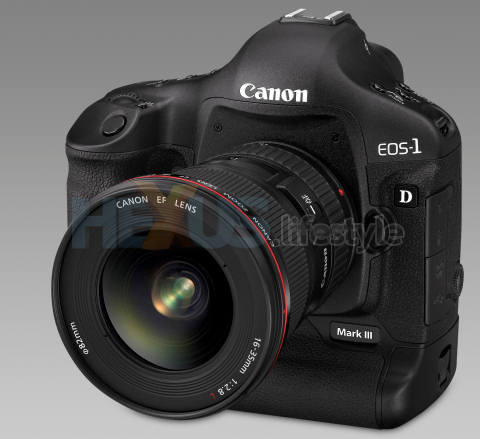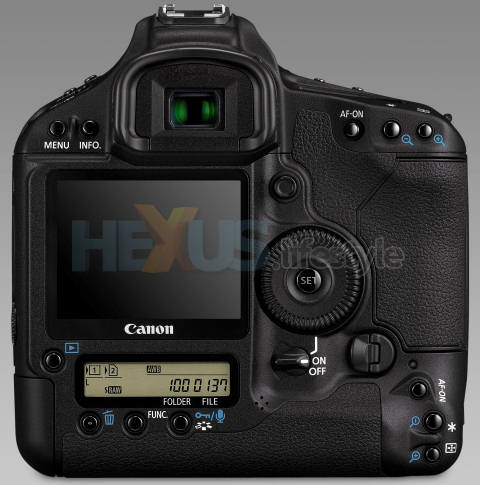The news
Canon is readying to launch 43 new products over the coming months, led by what's claimed to be the world's fastest digital camera. This is a new flagship professional SLR, the EOS-1D Mark III, reckoned to be able to shoot 10 frames a second in JPEG and RAW modes and take 110 JPEGs or 30 RAWs non-stop.
We'll be looking at other newcomers in the company's 2007 Spring Collection - concentrating on printers and compact digital cameras - so keep an eye on the HEXUS.lifestyle front page. But, for now, we'll focus (groan!) on the latest EOS, tentatively schedule for an April introduction.
Successful pros whose camera purchases are tax-deductible may not worry about the cost of the Mark III but, nonetheless, the suggested price - £3,050 (and we don't yet know if that even includes a lens) - looks to be massively more than the street price of its predecessor. The Mark II N can currently be had (body alone) for under £1,900.
That low price may partly be because there's typically a significant difference between suggested and street prices. But it may also be that, since the Mark II is now discontinued, it's being flogged off cheaply (if that's an appropriate way to describe a £1,900 camera).
Click for larger image
Whatever the price of the new Mark III, however, we tend to agree with Canon's party line that this will be the camera that many professionals aspire to having in their kit bags next.
The company says that the Mark III is a complete back-to-the-drawing-board effort - the only way it could include so many of the improvements that pros said that they most wanted, among which was a bigger LCD monitor (3in and brighter than the Mark II's 2.5-incher) and one that offers live preview.
Faster shooting was a key consideration, simply because it increases the likelihood that any photographer taking action pictures will get that illusive best shot. The Mark III's 10fps, paired with a 110-shot burst, is a massive improvement on what the Mark II offers in JPEG mode, 8.5fps and a 48-shot burst (22 RAWs).
Click for larger image
These improvements (and the live preview) have been made possible by using two digital processors - and the Mark III centres on new-generation DIGIC III jobbies rather than DIGIC II as is the case with the Mark II's single processor.
Moving to DIGIC III brings a couple of other major advantage - finer image processing (14-bit) and the ability to use a higher-resolution (10.1 Megapixel - APS-H size - 28.1x18.7mm) CMOS sensor - and that's another step up compared to the Mark II EOS 1D's 8.2 MP CMOS unit.
Not so high-tech, but no less important, the newcomer is said to be more reliable thanks to a 50 per cent increase in shutter durability. Canon says the shutter has been test to 300,000 cycles.
And the camera is significantly lighter than its forerunner, though to a non-pro it will still feel like you're lugging a couple of house bricks.
Weight of the body is alone is 1155g (over 2.5lb), with the battery adding a further 180g (6oz+). Figures for the MkII are 1225g (2.7lb) and 335g (11.9oz).
So the total weight, before sticking a lens on the front or a flash on the top, is 255g (9oz) less.
Click for larger image
According to the specs that Canon put out yesterday, the dimensions of the Mark III are exactly the same as the Mark II - 156.0(w) x 157.6(h) x 79.9(d) mm. We've double-checked this and the company says that's correct but we still have our doubts about how the two can be identical in size.
Dust on image sensors is big issue with digital SLRs and even more for pro users than us ordinary folk. So professionals will be pleased to hear that the Mark III has what's described as a new and better integrated cleaning system.
Also on the list of enhancements are a new auto focus system with 19 cross-type sensors; a 63-zone exposure metering method; and a wider range of ISO settings than the Mark II - 100-3200 ISO as standard, expandable by processing magic to 50-6400.
So, all very tasty and something that gives us clues of the sorts of features we can expect to enjoy in consumer digital SLRs a couple of years down the road.
Thoughts? Share 'em with us in this HEXUS.lifestyle news thread but look first, if the mood takes you, at the full specs (PDF, 33KB - right-click to download) and the press releases that follow on pages two (for techies) and three (for dummies).
HEXUS.links
HEXUS.community :: discussion thread about this articleHEXUS.lifestyle - news :: Canon - would-be King of Europe - range preview
HEXUS.lifestyle - news :: Canon HV20 - HDV camcorder with 25p cine mode & HDMI out
External.links
Canon UK - http://www.canon.co.uk; 08705 143723Canon Eire - http://www.canon.ie; (01) 2052400












